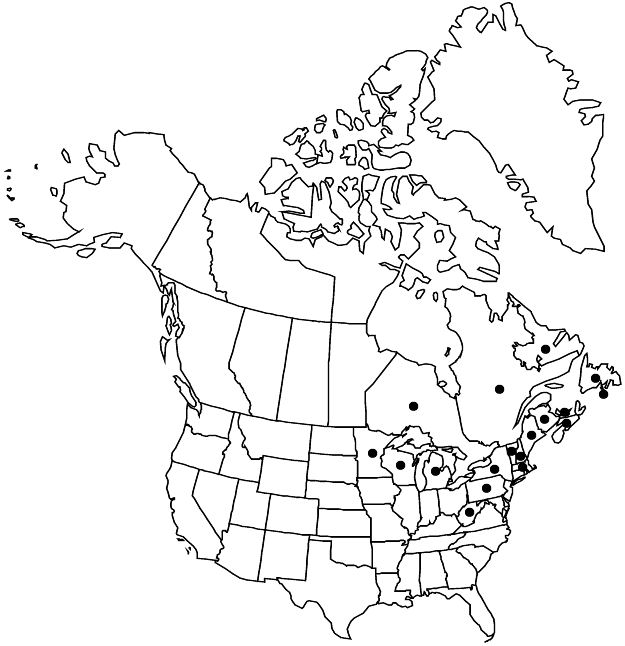Amelanchier bartramiana
Fam. Nat. Syn. Monogr. 3: 145. 1847.
Shrubs, 0.3–2.5(–5) m. Stems 1–50, fastigiate, suckering and forming ± dense colonies. Leaves half-unfolded; petiole (2–)4.5–10.5(–25) mm; blade narrowly elliptic-oval to oblong to broadly oval, (26–)37–51(–74) × (12–)20–29(–48) mm, base usually cuneate, each margin (2–)8–14(–27) teeth on proximal 1/2 and (2–)7–12(–21) teeth in distalmost cm, largest teeth less than 1 mm, apex acute to rounded, abaxial surface sparsely (moderately) hairy (or glabrous) by flowering, glabrous or sparsely hairy later, adaxial glabrous (or sparsely hairy) later. Inflorescences (1 or)2 or 3(or 4)-flowered, (6–)13–25(–38) mm. Pedicels: (0 or)1(–3) subtended by a leaf, proximalmost (4–)11–21(–35) mm. Flowers: sepals ascending to recurved after flowering, (1.7–)2.7–3.9(–6) mm; petals oblong-oval to broadly elliptic, (5.5–)7.1–8.7(–16.9) × (2.6–)3.9–5.3(–7) mm; stamens (8–)18–21(–25); styles (3 or)4 or 5, (2.7–)3.8–5.2(–6.1) mm; ovary apex densely hairy (or glabrous). Pomes dark purple, pear-shaped, 10–15 mm diam. 2n = 2x, 3x, 4x.
Phenology: Flowering May–Aug; fruiting Jul–Sep.
Habitat: Cool woods, mountain slopes, summits, bogs, poor fens, conifer swamps, acidic soil, sandy lake shores, stream banks, rocky ridges, roadside thickets
Elevation: 0–1500 m
Distribution

St. Pierre and Miquelon, N.B., Nfld. and Labr., N.S., Ont., P.E.I., Que., Maine, Mass., Mich., Minn., N.H., N.Y., Pa., Vt., W.Va., Wis.
Discussion
Amelanchier bartramiana is the only North American Amelanchier with leaves that are imbricate in bud, usually fewer than four flowers per inflorescence, and conic ovary apices (and hence fruits that are more or less pear-shaped rather than globose as in other members of the genus). Because of these differences, P. Landry (1975) placed A. bartramiana in its own subgenus, and all other members of the genus in another. W. H. Blanchard (1907), W. A. Robinson and C. R. Partanen (1980), and Robinson (1982) also recognized the distinctness of this species. Amelanchier bartramiana grows farther north than any other shadbush in eastern North America, and more than other shadbushes, it occupies relatively undisturbed habitats, such as peatlands and natural breaks in mature forests. Some plants in this species produce seed sexually (C. S. Campbell et al. 1987). Sexual plants of A. bartramiana are self-incompatible diploids; a tetraploid individual has been reported (A. C. Dibble et al. 1998); it had relatively large petals and might have been an autotetraploid.
Amelanchier bartramiana usually flowers with A. laevis, and it frequently hybridizes with other members of the genus. M. L. Fernald (1950) and L. Cinq-Mars (1971) reported hybrids with A. arborea (A. ×quinti-martii Louis-Marie), A. canadensis, A. fernaldii, A. gaspensis, A. humilis, A. intermedia, A. laevis, A. sanguinea, A. spicata, and A. interior. The hybrid with A. laevis can usually be found when these two species grow together (J. E. Weber and C. S. Campbell 1989). The authors have documented a hybrid between A. arborea and A. bartramiana in eastern Pennsylvania (M. B. Burgess et al., unpubl.).
Selected References
None.